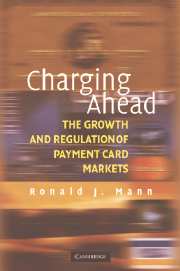Book contents
- Frontmatter
- Contents
- Figures and Tables
- Acknowledgments
- Introduction
- PART I THE BASICS OF PAYMENT CARDS
- PART II EASY MONEY
- PART III THE PUZZLE OF PAYMENT CARDS
- PART IV REFORMING PAYMENT SYSTEMS
- PART V OPTIMIZING CONSUMER CREDIT MARKETS AND BANKRUPTCY POLICY
- Conclusion
- Appendix: Country-Level Data
- Notes
- Bibliography
- Index
PART V - OPTIMIZING CONSUMER CREDIT MARKETS AND BANKRUPTCY POLICY
Published online by Cambridge University Press: 06 July 2010
- Frontmatter
- Contents
- Figures and Tables
- Acknowledgments
- Introduction
- PART I THE BASICS OF PAYMENT CARDS
- PART II EASY MONEY
- PART III THE PUZZLE OF PAYMENT CARDS
- PART IV REFORMING PAYMENT SYSTEMS
- PART V OPTIMIZING CONSUMER CREDIT MARKETS AND BANKRUPTCY POLICY
- Conclusion
- Appendix: Country-Level Data
- Notes
- Bibliography
- Index
Summary
Sir Walter Scott was a dominating literary figure at the dawn of the nineteenth century. From poems like “The Lay of the Last Minstrel” and “The Lady of the Lake” to novels like Old Mortality, The Heart of Midlothian, and The Bride of Lammermoor, his works display not only an endearing and perceptive infatuation with the troubled history of his Scottish homeland, but a genius of “extraordinary range” and “the greatest diversity of realistic human characters outside Shakespeare.” Still, though his work has provided an addictive fascination to generations of readers and served as a fount of inspiration to later writers and composers, critical opinions of his work vary widely. It is fair to say that the received wisdom is that his early brilliance was compromised by the less imaginative work that occupied the last years of his life.
For present purposes, however, Scott is more useful as an example of financial distress. The story is well known. After a dispute with the publisher of his early (and financially successful) poems, Scott founded a new publishing house in 1809 with the Ballantyne Brothers, which quickly became seriously indebted to one Archibald Constable. Over the next few years, Scott's various activities, many of them backed or financed by Ballantyne and Constable, left Scott with debts of about £120,000, quite a large sum, even for the most successful writer of his age.
- Type
- Chapter
- Information
- Charging AheadThe Growth and Regulation of Payment Card Markets around the World, pp. 175 - 178Publisher: Cambridge University PressPrint publication year: 2006

